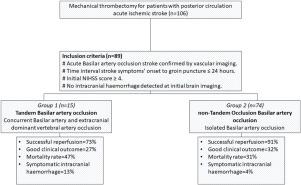Journal of Neuroradiology ( IF 3.0 ) Pub Date : 2020-09-08 , DOI: 10.1016/j.neurad.2020.08.004 Mahmoud Elhorany 1 , Grégoire Boulouis 2 , Wagih Ben Hassen 2 , Sophie Crozier 3 , Eimad Shotar 4 , Nader-Antoine Sourour 4 , Stephanie Lenck 4 , Kevin Premat 5 , Robert Fahed 6 , Vincent Degos 7 , Ahmed Mohamed Elhfnawy 8 , Ossama Yassin Mansour 9 , El-Sayed Ali Tag El-Din 10 , Wael Ahmed Fadel 10 , Sonia Alamowitch 11 , Yves Samson 12 , Olivier Naggara 2 , Frédéric Clarençon 13

|
Background
Tandem basilar artery occlusions (tBAO) are defined as concomitant basilar artery and extracranial dominant vertebral artery occlusions. The prognosis of such tBAO treated by mechanical thrombectomy (MT) has been scantly reported.
The purpose of our study was to compare the safety and effectiveness of MT for patients with tBAO compared to those with non-tandem basilar artery occlusions (ntBAO).
Patients and methods
Retrospective analysis of a database of patients who underwent MT at two academic centres. All patients treated for BAO were retrieved. Patients with tBAO, defined as a concomitant BAO and extracranial vertebral artery (VA) occlusion or severe stenosis ≥70% (V1 or proximal V2 segment) were compared with patients with ntBAO.
Results
A total of 15 patients with tBAO and 74 patients with ntBAO were enrolled. Successful reperfusion (modified thrombolysis in cerebral infarction score ≥2b) was obtained in 73.3% versus 90.5% (OR = 0.29, 95%CI: 0.07–1.15), good clinical outcome (3-months modified Rankin scale ≤2) was reached by 26.7% versus 32.4% (OR = 0.76; 95% CI: 0.24–2.63) and mortality at 3-months was 46.7% versus 31% (OR = 1.94; 95%CI: 0.63–6) of patients with tBAO versus ntBAO, respectively. Two patients (13.3%) with tBAO and three (4%) with ntBAO had symptomatic intracranial haemorrhage (OR = 3.64; 95% CI: 0.55–24).
Conclusion
Mechanical thrombectomy for patients with tandem basilar artery occlusion tends to be associated with lower rates of successful reperfusion and good clinical outcome, and higher rate of mortality. Larger multicentre studies are warranted to better precise the proper selection and management of such patients.
中文翻译:

机械血栓切除术治疗串联基底动脉闭塞的结果和再通率。
背景
串联基底动脉阻塞(tBAO)定义为基底动脉和颅外优势椎动脉阻塞。通过机械血栓切除术(MT)治疗的此类tBAO的预后报道很少。
本研究的目的是比较tBAO患者与非串联基底动脉闭塞(ntBAO)患者MT的安全性和有效性。
患者和方法
对在两个学术中心接受过MT治疗的患者数据库的回顾性分析。所有接受BAO治疗的患者均被收回。将tBAO患者(定义为同时发生BAO和颅外椎动脉(VA)阻塞或严重狭窄≥70%(V1或近端V2段))与ntBAO患者进行比较。
结果
共有15例tBAO患者和74例ntBAO患者入选。成功再灌注(改良型脑梗死溶栓评分≥2b)获得了73.3%vs 90.5%(OR = 0.29,95%CI:0.07-1.15),临床效果良好(改良的Rankin量表≤2个月为3个月) tBAO和ntBAO患者的3个月死亡率分别为26.7%和32.4%(OR = 0.76; 95%CI:0.24-2.63)和46.7%vs 31%(OR = 1.94; 95%CI:0.63-6),分别。有2例(13.3%)的tBAO患者和3例(4%)的ntBAO患者有症状性颅内出血(OR = 3.64; 95%CI:0.55–24)。
结论
机械性血栓切除术可治疗串联的基底动脉闭塞患者,这与较低的成功再灌注率和良好的临床结果以及较高的死亡率相关。有必要进行更大范围的多中心研究,以便更好地精确选择和管理此类患者。










































 京公网安备 11010802027423号
京公网安备 11010802027423号